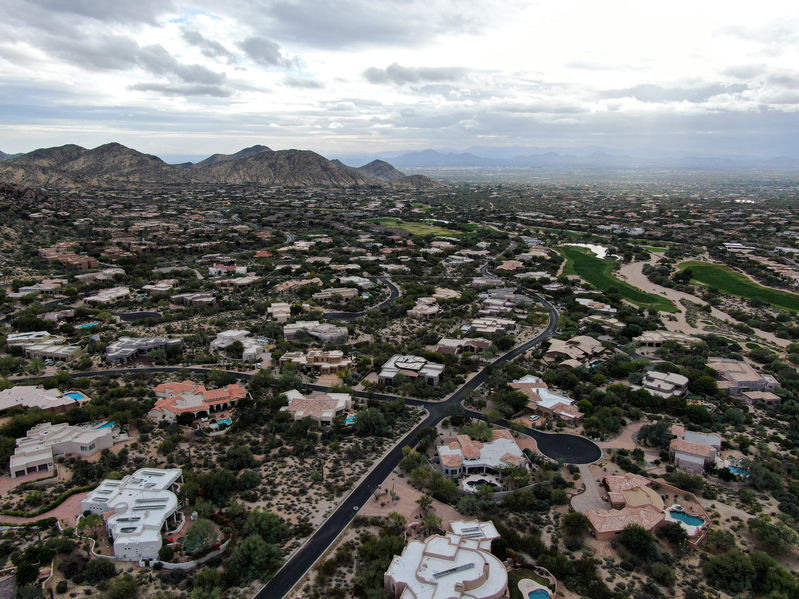While many industry sectors across Arizona and the U.S. have taken devastating hits during the prolonged COVID-19 pandemic, the state’s land market and housing market have shown incredible resiliency and more impressively, growth.
The 2021 Phoenix MSA population estimate is 5 million over the next two decades. A whopping 1.765 million new residents will require a total of 630,000 single family and multifamily housing units. The Phoenix MSA transaction volume for land of all types in 2020 was $3.62 billion. On the housing side, COVID-fueled suburban migration benefitted single-family demand, and single-family permits rose 17%.
COVID-19 in 2020 created numerous changes, forcing consumers to adapt to a new normal. We’re watching movies via streaming. Restaurant service is takeout and delivery. Personal trainers are on our screens. Consumers have embraced new shopping behaviors. How much of it will stick? That was the question as Scottsdale-based Land Advisors Organization held its annual Metro Phoenix Land and Housing Forecast – this year as a virtual event with more than 800 participants.
When it comes to land, CEO of Land Advisors Organization Greg Vogel said the demand metrics have radically changed for builders and developers. He noted that 2020 was another banner year for the Metro Phoenix land market, one that heads into 2021 with a full head of steam.
“Today’s presentation is a really nice backdrop for an amazing run that Phoenix is on,” Vogel said. “Metro Phoenix will remain in the top tier for housing, population and job growth 2021-2025. It will be difficult to ‘build our way out’ of this housing shortage. We are and will remain a land of great opportunity.”

Rick Palacios Jr., Principal/Director of Research of John Burns Real Estate Consulting also presented, provided housing outlook insights.
“There will be a post-COVID new normal in housing. Expect some builder processes to permanently shift along with consumer adoption. The 2021 economic outlook is positive, aided by a “stimulus on steroids.” Today’s housing market remains very strong, with work from home likely a longer-term structural positive for the industry,” Palacios said.
He added the 2021 housing outlook is positive with the lack of supply of lots for homes to sell being the biggest risk factor for homebuilders. He said to expect strong price appreciation until supply catches up with demand.
“We’re transitioning from a normal to boom home price cycle. The single-family rental outlook keeps getting rosier. Rents are heading higher and the build-for-rent bonanza is just getting started.”
Where in Metro Phoenix is the brisk activity? The Loop 303 corridor in the West Valley is seeing incredible growth, Vogel and Palacios said. Additionally, we are seeing incredible growth through Buckeye and Pinal County.
The West Valley led Metro Phoenix single-family permits pulled in 2020 with 14,607. Second was the East Valley, 8,101; third was Pinal County, 5,996.

Other takeaways form the event:
• Headwinds: Rising costs and prices. Processing time for initial application to building permit. Wages not keeping up with rents and purchasing power. Water constraints. Clawing back from joblessness in the hospitality, travel and restaurant sectors. Prop 208.
• Tailwinds: Sustainable growth in population and employment. Low government regulations compared to other regions. Cooperative regionalism. Cities rationalizing and support of higher density. Transfers of wealth from Baby Boomers to Gen X.
• Active adult community permits accounted for 6.6% of the market. Arizona’s 65+ population is increasing at more than twice the rate of other age groups. 1,888 permits were pulled in 2020. We expect the share of Active Adult to grow as COVID fears and restrictions are lifted.
• Of the U.S. population of 330.6 million, Arizona accounts for only 2.2% but is capturing 6.9% of U.S. population growth.
• Metro Phoenix resale days of supply (net of pending): In January 2015 for all listings, it was 104 days; 79 days for homes $350,000 and less. In January 2021, the market is looking at 16 days for all listings; 8 days for houses $350,000 and less. The chronic shortage in the resale market is forcing buyers to new homes creating crushing demand.




